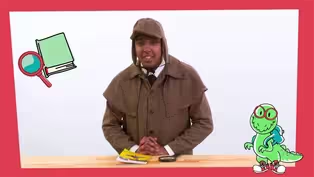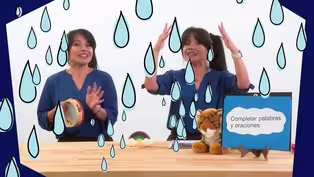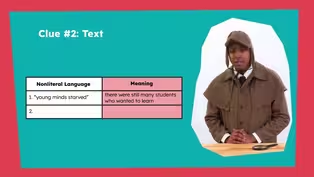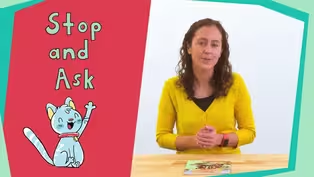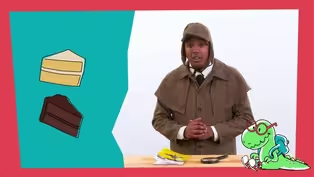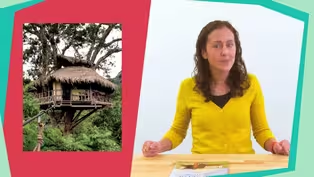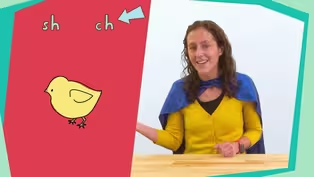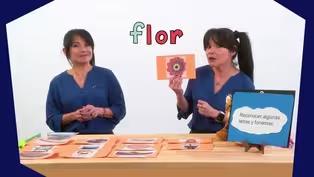
Episode 23 | Literacy Lessons
4/6/2021 | 28m 46sVideo has Closed Captions
Literacy lessons for early learners, led by NC teachers.
The first lesson (aimed at PreK-K learners) focuses on concepts of print and vocabulary development. The second lesson (aimed at 1st-2nd graders) helps early learners identify story elements and key details of text. Classroom Connection is your At-Home Learning companion where children love to learn. All lessons are led by NC educators.
Problems playing video? | Closed Captioning Feedback
Problems playing video? | Closed Captioning Feedback
At-Home Learning Presents: Classroom Connection is a local public television program presented by PBS NC

Episode 23 | Literacy Lessons
4/6/2021 | 28m 46sVideo has Closed Captions
The first lesson (aimed at PreK-K learners) focuses on concepts of print and vocabulary development. The second lesson (aimed at 1st-2nd graders) helps early learners identify story elements and key details of text. Classroom Connection is your At-Home Learning companion where children love to learn. All lessons are led by NC educators.
Problems playing video? | Closed Captioning Feedback
How to Watch At-Home Learning Presents: Classroom Connection
At-Home Learning Presents: Classroom Connection is available to stream on pbs.org and the free PBS App, available on iPhone, Apple TV, Android TV, Android smartphones, Amazon Fire TV, Amazon Fire Tablet, Roku, Samsung Smart TV, and Vizio.
Providing Support for PBS.org
Learn Moreabout PBS online sponsorshipMore from This Collection
Video has Closed Captions
Literacy lessons for early learners, led by NC teachers. (28m 46s)
Video has Closed Captions
Literacy lessons for early learners, led by NC teachers. (28m 46s)
Video has Closed Captions
Literacy lessons for early learners, led by NC teachers. (28m 45s)
Video has Closed Captions
Literacy lessons for early learners, led by NC teachers. (28m 45s)
Video has Closed Captions
Literacy lessons for early learners, led by NC teachers. (28m 46s)
Video has Closed Captions
Literacy lessons for early learners, led by NC teachers. (28m 46s)
Video has Closed Captions
Literacy lessons for early learners, led by NC teachers. (28m 45s)
Video has Closed Captions
Short Description: Literacy lessons for early learners, led by NC teachers. (28m 45s)
Video has Closed Captions
Literacy lessons for early learners, led by NC teachers. (28m 45s)
Video has Closed Captions
Literacy lessons for early learners, led by NC teachers. (28m 45s)
Video has Closed Captions
Literacy lessons for early learners, led by NC teachers. (28m 45s)
Video has Closed Captions
Literacy lessons for early learners, led by NC teachers. (28m 45s)
Providing Support for PBS.org
Learn Moreabout PBS online sponsorship[cheerful upbeat music] ♪ - I talk all the time about how important our brains are.
But check this out.
Only half of a dolphin's brain goes to sleep when they're sleeping, and the other half stays awake.
Maybe that's so they can swim away real quickly if they get into trouble.
I bet your brain is always active, especially during this literacy lesson we're about to get into.
Here it is.
- Hello, super learners.
My name is Ms. Jennifer, and I'm so excited that you are here to learn with me today.
You will need a stuffed animal for today's lesson.
Ask a trusted adult to help you find it.
While you're getting your supplies, I'm gonna grab mine as well.
I'll be right back!
[air whooshes] [bright music] Okay, I'm back now, and I see you are too.
We have our stuffed animal so now let's get started.
Today we're gonna be reviewing the parts of a book, making sure to read from left to right, and sorting animals into categories.
We will also read a story about baby animals and make a connection to another story we read.
Are you ready?
[air whooshes] All right, super learners.
Let's get started.
Here is our book for today.
It is called "Is It a Baby Animal?"
The author of this story is Bridget Taylor.
She wrote the words we will be reading.
This book does not have an illustrator because there are no drawn pictures.
The pictures in this story are photographs of real animals.
This part of the book is called the front cover.
It has the title, "Is It a Baby Animal?"
The author's name, Bridget Taylor, and a picture showing what the story is about.
This is the back cover.
Remember that the front and the back cover work together to protect the pages.
This is the spine.
It holds the pages together.
Now, let's go back to the front cover.
Take a look at the picture.
In the picture, we can see some animals.
Let's name these animals.
We have a bear, a kitten, a puppy, and a duckling.
I wonder if we will see any other animals in our story?
What other animals do you hope to learn about?
Ooh, a wolf, alligator, fish?
There are so many options.
Let's find out!
When we open our book, the first page we come to is the title page.
Do you remember why it is called the title page?
That's right, it has the title on it.
We can see it right here.
"Is It a Baby Animal?"
Now, let's read our book and find out if the animals we see are baby animals or adult animals.
Adult is another way to say grown-up.
Now, I'm going to start reading on the left and go to the right.
"Is a kitten a baby animal?
A kitten is a baby cat.
Is a puppy a baby animal?"
Tell your stuffed friend.
"Yes, it is!
A puppy is a baby dog.
Is a cub a baby animal?"
Tell your stuffed friend.
"Yes, it is!
A cub is a baby bear.
Is a duckling a baby animal?"
Tell your stuffed friend.
"Yes, it is.
A duckling is a baby duck."
Wow, we learned a lot of animal names.
Some of the animals were adult animals and some were baby animals.
We can tell that an animal is a baby because it is smaller than the adult.
We have some pictures of animals.
[air whooshes] Some of them are adult animals and some are baby animals.
I need to sort them by deciding if they are adult animals or baby animals.
I'm going to write on the board.
I'm going to write the word adult on this side.
Then I'm going to write baby on this side.
I'll need your help so that I put the animals in the right places.
So, first, we have a cat.
Tell your stuffed friend if a cat is an adult or baby animal.
Did you say a cat is an adult?
That's right.
In our story, we learned that a cat is an adult animal.
I'm going to put it on the adult side.
Now, can you stand up tall and meow like a cat?
Meow!
Meow!
Now, we have a kitten.
Tell your stuffed friend if a kitten is an adult or baby animal.
Did you say a kitten is a baby animal?
That's right.
We learned from our story that a kitten is a baby cat.
Can you crouch down low and meow like a kitten?
Meow!
Meow!
Great job.
Now, we have a dog.
Tell your stuffed friend if a dog is an adult or baby animal.
Did you say a dog is an adult?
That's right.
In our story, we learned that a dog is an adult animal.
Can you stand up tall and bark like a dog?
Woof, woof!
Now, we have a puppy.
Tell your stuffed friend if a puppy is an adult or baby animal.
Did you say a puppy is a baby animal?
That's right.
We learned from our story that a puppy is a baby dog.
Can you crouch down low and bark like a puppy?
Now, we have a bear.
Tell your stuffed friend if a bear is an adult or baby animal.
Did you say a bear is an adult animal?
That's right.
In our story, we learned that a bear is an adult animal.
Can you stand up tall and growl like a bear?
[growls] Now, we have a cub.
Tell your stuffed friend if a cub is an adult or baby animal.
Did you say a cub is a baby animal?
That's right.
We learned from our story that a cub is a baby bear.
Can you crouch down low and growl like a cub?
Now, we have a duck.
Tell your stuffed friend if a duck is an adult or baby animal.
Did you say a duck is an adult?
That's right.
In our story, we learned that a duck is an adult animal.
Can you stand up tall and quack like a duck?
Quack, quack, quack, quack!
Now, we have a duckling.
Tell your stuffed friend if a duckling is an adult or baby animal.
Did you say a duckling is a baby animal?
That's right.
We learned from our story that a duckling is a baby duck.
Can you crouch down low and quack like a duckling?
Now, we have a pig.
Tell your stuffed friend if a pig is an adult or baby animal.
Did you say a pig is an adult?
That's right.
We saw this animal in our story "Little Piglets."
Can you stand up tall and oink like a pig?
Oink, oink!
Now, we read another book about mother pig.
Do you remember that story?
Now we have a piglet.
Tell your stuffed friend if a piglet is an adult or baby animal.
Did you say a piglet is a baby animal?
That's right.
We learned from our story that a piglet is a baby pig.
Can you crouch down low and oink like a baby pig?
In our story, "Little Piglets," those silly piglets were hiding from their mother pig.
Do you remember where she found them?
Tell your stuffed friend.
That's right, they were hiding beside the barn.
Now, we have a sheep.
Where should we put it?
On the adult side or the baby side?
That's right, we should put it on the adult side.
Now, we have a lamb.
Tell your stuffed friend if a lamb is an adult or baby animal.
Did you say a lamb is a baby?
That's right.
We saw this animal in our story "Little Pigs."
Can you crouch down low and bah like a lamb?
Now, we have a hen.
Where should we put it?
On the adult side or the baby side?
That's right.
We should put it on the adult side.
A hen is a female or girl chicken.
For our last animal, we have a chick.
Tell your stuffed friend if a chick is an adult or baby animal.
Did you say a chick is a baby animal?
That's right.
We saw this animal in our story "Little Piglets."
Can you crouch down low and peep like a chick?
Peep, peep!
Peep, peep!
[air whooshing] [gentle music] You did an excellent job making animal sounds.
You did such a good job telling me who the adult and baby animals were.
Super learners, we are at the end of our lesson for today.
Thank you so much for being with me as we reviewed the parts of a book, made sure to read from left to right, and sorted animals into categories.
I'll see you next time!
[air whooshes] - Hey there.
All this learning is making my brain grow.
Let's check out the next video that'll make your heart bigger too.
I love my neighbors.
- [Narrator] Hi, helpers.
Have you noticed that people have differences even though we are all human beings?
Some people have brown skin and others have white skin.
Some have straight hair and some have curly hair.
Some people have no hair at all.
Our differences are wonderful because they make every person one of a kind.
Meeting new friends lets us learn about how other people are different and similar to you.
You can be a helper by being proud of your differences and respecting the differences in other people too.
- Today's affirmation is love is all around me.
[relaxing music] Are you ready?
Love is all around me.
Love is all around me.
Love is all around me.
- All right.
I read something that made me giggle.
A shrimp's heart is located in their head!
That's really different, right?
Do you know where your heart is located?
That's right.
You know that's where love comes from?
Now, let's put both our heads and our hearts to use in this next lesson.
Here it goes.
[chill music] - Hi, readers!
My name is Ms. Gary, and I'm so excited to be learning with you today.
Before we get started with our learning, let's say hello with our welcome song.
♪ Hello, readers ♪ ♪ Hello, readers ♪ ♪ How are you ♪ ♪ How are you ♪ ♪ I'm so glad to see you ♪ ♪ I'm so glad to teach you ♪ ♪ Hello, you ♪ ♪ You and you ♪ Readers, have you ever been reading and thought, "Wow, there's a lot going on in this story.
How will I ever keep track of the stuff I'm reading?"
Well, as a reader, we can often look at the title of the book and preview the book by looking at the pictures before we begin reading.
Specifically, if we're reading a picture book.
This is a strategy that good readers will use.
Today, we're going to use story elements to help us comprehend or understand what we're reading.
We're going to read a folktale today.
A folktale is a story that was told long ago, and it was passed down so that we are able to listen to and read these stories today.
The folktale that we're going to read today is "The Enormous Turnip."
The author of this book is Bridie McBeath.
The person that draws the pictures that we look at, that's the illustrator.
The illustrator of this book is Jo Sinclair.
So take a look at the cover of this book.
What do you think is happening here?
Think about what you notice, and tell me something that you notice on this cover.
Hmm.
You notice that too?
I see two people and they're pulling a really big vegetable.
So let's look at the title again.
"The Enormous Turnip."
The word enormous, it is used to describe something really big.
So, what do you see on the cover of this book that's really big?
Hmm, it looks like that vegetable that they're pulling is really big or enormous.
I know that the title of the book is "The Enormous Turnip" so I'm guessing that they're pulling a really big turnip.
We're going to get ready to read our story.
But as a reader, you want to make sure that you're always listening and paying close attention to the story elements.
Well, what are the story elements?
Let me tell you.
Story elements are the characters, or who is in the story, like the people or the animals or things.
We also have the setting of our story.
The setting is where and when our story takes place, like in a house.
A story can't be a story without a problem.
Uh-oh.
What went wrong in the story?
What's the challenge?
We also will have a solution.
The solution is how the story is solved.
So today, as we read, we're going to be reading to find out who the story is about, where the story takes place, what problem our characters encounter, and how they will solve this problem.
So, are you ready to get started reading?
Let's go.
"The Enormous Turnip."
"In spring, Mr. Farmer planted turnips seeds.
Soon, turnips began to grow."
Let's pause for a second there.
Look at where they're at.
Hmm, I wonder if we know who the character is yet: "Mr. Farmer went to check his turnip.
He saw that one turnip was bigger than the rest."
So I've heard the farmer mentioned more than one time.
So I think he's the character in the story.
Did you hear where the story takes place?
Yeah, it said in spring he plants the turnips.
So, the farmer is planting turnips and is planting turnips in spring in a field.
So let's keep reading.
"Mrs. Farmer went to see the big turnip.
And now the turnip was as tall as the scarecrow."
My goodness, look at the farmers' faces.
How do you think they're feeling?
I agree.
Probably a little bit surprised to see such a large or enormous turnip: Well, the turnip kept getting bigger.
Now it was as big as the farmer's house.
"That is an enormous turnip," said Mr. Farmer.
"It's time to pull it up."
Look at how huge that is.
How are they ever gonna pull that enormous turnip out of the ground?
We're gonna keep reading to find out: Mr. Farmer tied a rope around the enormous turnip.
He pulled and pulled.
But the enormous turnip did not move.
"I will help you," said Mrs. Farmer.
And they pulled and pulled.
But the enormous turnip did not move.
Hmm.
That seems like a problem.
Do you remember that we're supposed to be listening for a problem?
So maybe this big turnip being stuck in the ground is a problem.
What do you think?
Yes or no?
You gave me a thumbs up?
I agree.
Let's see what happens next: The children said, "I will help you!"
And they pulled and pulled.
But the enormous turnip did not move.
Oh my goodness: "We will help you," said the neighbors.
They pulled and pulled.
But the enormous turnip did not move.
Oh man, are they ever gonna get this out: "The farmer needed more help.
The animals pulled too.
But the enormous turnip did not move.
Oh my gosh, look at that.
Their faces!
They're probably exhausted.
Well, let's see what happens: A mouse came to help.
The mouse gave the rope a big tug and the enormous turnip popped out of the ground!
[gasps] Problem solved it seems like: Mrs. Farmer made turnip soup.
She made turnip pie too.
She even made turnip ice cream.
What a good meal they had.
"What will we plant next year?"
asked the farmer.
"How about watermelons?"
said Mrs. Farmer.
Wasn't that a great story, readers?
So now that we've listened to the story, it's your turn to see if you can tell me what the story elements are in "The Enormous Turnip."
To do this, you're going to create your own graphic organizer that's going to help you stay organized and identify all the components to our story elements.
So you're going to need a piece of paper and something to write with.
Go grab that and then come right back.
[air whooshes] [gentle music] I'm back, readers.
And I grabbed my piece of paper and something to write with.
We're gonna go ahead and fold our paper so that we have four quarters and we're able to write our character, setting, problem, and solution in each box.
So go ahead and fold your paper in half, hamburger style, just like this.
Then fold it again, hot dog style, just like this.
Now you have four quarters, one for each of our story elements.
So let's take a look at our first element, the characters.
Do you remember who the main character in the story is?
Think about what we read.
Hmm.
Did you say that the character was the farmer and his wife?
If you did, you're correct.
The characters are the farmer and his wife.
Now it's time to determine where in the world did this story "The Enormous Turnip" take place.
So, in your next box, setting, you're gonna think about where and when did our story take place.
Hmm.
Think about it.
I remember our story took place in spring in a turnip field.
So you can draw a picture or write turnip field on your setting square.
So now I know who the characters are and I know where the story took place.
But what was the problem?
Can you tell me the problem that our farmer was having?
I want you to think about the title.
That could help you.
What was the problem?
That's right.
That enormous turnip got stuck in the ground.
And just like on the cover, they couldn't pull it out.
So the children and the neighbors and the animals had to come help.
But did they get it out?
Hmm, nope!
So how did they solve this problem?
Well, think about it.
Who came along at the end?
That's right.
The little mouse came along, and that little mouse pulled on that string, and pop, out came the turnip!
Good readers are always thinking about what's happening in the story.
And today you demonstrated that you are a good reader and a good listener, because you identified all the story elements in our folktale "The Enormous Turnip."
So thank you so much for joining me today as we learned about using the story elements: the characters, the setting, the problem, and the solution.
I hope you all loved listening to this story.
And remember, you can use the story element graphic organizer for any fictional story that you read, or even movies.
So the next time that you're reading a fiction text like this, or watching one of your favorite movies, see if you are able to identify the story or movie's elements.
I'll see you next time, readers, bye!
- I've been waiting for the perfect time to share this next video with you.
Check it out.
[graphic popping] ♪ Du-du du-du du-du du-du du-du-du ♪ - [Narrator] Once upon a time, Sylvia noticed her friend sitting all alone.
When Sylvia asked her what was wrong, she frowned and said, "I'm just too different from everyone else."
Sylvia smiled at her and said, "We're all different, but the beauty of being Imagifriend is that we accept each other for who we are."
The friend smiled and thanked Sylvia before going to play with the others.
Sylvia is always excited to accept the differences between her friends.
That's what makes her so special.
- Hi, everyone.
I'm Ms. Raven, and today we are going to get active.
I want you guys to join me by moving your arms from side to side.
[chill music] We're just gonna swing them here.
And every time I swing, my toe is tapping.
Good job, and we'll lift them up.
And back to our center.
And this time we're just gonna curl our biceps in.
And back to center.
You're doing great!
We're gonna come up this time.
Here we go, and up!
And back to center.
Good.
And biceps.
Great job!
And thank you for joining me today.
I will see you next time.
- That was a great lesson.
I'm so glad you were here to share it with me.
We have so much we can learn and I'm so thankful we're able to share this time together.
[cheerful upbeat music] ♪
Support for PBS provided by:
At-Home Learning Presents: Classroom Connection is a local public television program presented by PBS NC
